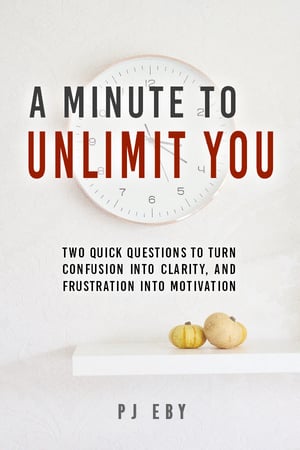It was Wednesday morning when I learned how to do it. My limbs were stiff and sore from sitting at the conference tables all day on Monday and Tuesday. My whole body was in some degree of pain. I needed to work out the knots somehow. But how?
In the last few weeks, I’ve been learning to disbelieve in obstacles. I used to have that attitude when I was younger, but it was very superficial. I would talk a good game, but when things actually got difficult I would chicken out, or decide that what I was after wasn’t really that important, after all.
But in mid-February, I attended a workshop that was supposed to be on Internet marketing topics. However, most of the speakers at the workshop talked about their personal histories in ways that made me realize that they were successful in direct proportion to the degree that they made conscious use of the thing I’ve been calling “command mode”.
None of them called it that, of course, especially since none of them read my blog. (At least, not as far as I know!) However, one of the speakers was a fitness guru who has previously spoken about the importance of using visualization and feeling while exercising, and it reminded me of one of the first times I “discovered” command mode.
It was several years ago that I first stumbled onto the key to command mode, but I didn’t know what I had found at the time. What happened was that I was doing some aerobic exercise, and as my mind wandered, I thought about what I wanted to look like physically, mentally projecting a “future self”. I then moved that image so that it overlapped my body as I was running, as I wondered what it would feel like to be doing the same exercise with that future body.
What happened shocked and surprised me. The effort I was putting out to do the exercise dropped dramatically. It was as if I was actually exercising with my future body. Since the exercise was supposed to be effort-based, I had to exercise much harder to produce the same sensation of effort!
Now, if you think that’s crazy, here’s an even crazier thought: I didn’t do it again, except maybe once or twice just for the heck of it. In fact, it wasn’t until a few months ago that I “rediscovered” it while running on a treadmill. I just happened to do the same thought process, and it was as if the treadmill had slowed to a crawl. I had to nearly double my running speed to get the same perceived effort back. I then remembered the previous experience from a few years prior, and thought, “ah, there it is again.” And then, like an idiot, I promptly forgot about it again.
Of course, the problem is that I didn’t really know what I had discovered. I had even heard once that you should visualize the results you want when you exercise, but I didn’t really make the connection. Visualizing the result isn’t enough, however. Have you ever heard that saying about how you should dress for the job you want, not the one you have? Well, I discovered that the best way to increase your workout intensity is to exercise with the body you want, not the one you currently have.
But the effect isn’t limited to exercise, and I didn’t really make that connection until sometime after writing Being the Body, before I began documenting the idea in Pleasure, Prediction, Progress. You see, in-body visualization will let you do pretty much anything; it’s essentially a direct line to your “other self”.
But back to the workshop I was in a few weeks ago, and the fitness guru. One of the stories he told was that he actually stumbled on this concept two or three times, using it to win various athletic competitions, but not making it a habit and therefore not having things go as well all the time. Finally, he learned to use it consciously, built his current business empire, and has been teaching the concept to others ever since.
So, while I already was aware of the technique myself, and had stumbled on its importance in limited applications, getting to hear all these speakers and see the different ways they had applied it was a real eye-opener. It was like I had invented the internal combustion engine, but these guys were already selling cars, trucks, and boats. I had no idea that it was so powerful and could be used for so many things. I had only used the idea in “first gear”, and these guys were racing.
What would you do, if you knew you would not fail?
So I learned a lot in a few days, and I don’t mean that I picked up a lot of information – though I did that too. It was the kind of learning that actually changes you. The speakers challenged us to stretch our ideas of what was possible for us; to make true commitments, and to affirm our worth with our actions, not our words. And their words echoed in my head long after I left the building, forcing me to stretch my self-concept beyond its previous limits.
They stirred up a conflict in me, between fear of success, and fear of failure. They made me realize that I was comfortable with failure in my personal life, as long as it was due to half-measures. As long as I hadn’t fully committed myself, I could shrug it off as “not really my fault”.
The real breakthrough took place after the workshop was over, the night before I headed home. I had been agonizing over whether or not I should join the very expensive follow-up coaching program that had been promoted at the workshop. On the one hand, I felt that the cost of the program and its regular deadlines would be a good spur to action. On the other, I feared that the program would just be a crutch to prop up my inability to follow through, or worse still, that nothing would come of it and I would just be wasting the money.
After talking with Leslie on the phone for quite some time that evening, however, I finally realized the flaw in my reasoning. At some point, it dawned on me that it didn’t matter what I chose to do, or what the outcome was, because I was treating it as a given that I would fail. That is, I was thinking that these were the only options:
- Take the additional coaching and fail, wasting the money
- Take the additional coaching and succeed, but still be a failure because clearly I needed a crutch
- Not take the coaching and fail
The logical fourth possibility, of not taking the coaching but succeeding anyway, was not something I seriously considered. I basically believed that what would really happen would be that I’d make some show of effort, let it fall off, and then blame the circumstances for the failure, such as telling myself I should’ve gotten the coaching after all.
The truth was, I simply didn’t believe in any possibility of success, and I didn’t believe in myself. Not only that, but I realized that I was actually comfortable with that belief. Indeed, the option that seemed most comfortable for me was to not take the coaching and fail, because it offered the most convenient rationalization and would have the least damaging consequences of the choices. I wouldn’t be out any more money, I wouldn’t blame myself, and I wouldn’t have to do as much work!
The Lives We Deserve
As I mentioned in Life is Every Moment, the truth is that we all have the life that we in some sense “deserve”. Not in the moral sense, but in the practical sense. We have the life that results from the decisions we make, and we make the decisions we do because of our perception of the costs and benefits involved. And if we are unaware of how we “score” the costs and benefits, we may well be doomed to making decisions that result in a life we don’t really want to have.
And clearly, that was the case for me. As soon as I realized how I was scoring my options, it became quite clear that the rules had to change. If I didn’t believe in myself, it literally didn’t matter what decision I made. The game was rigged, and I was bound to lose. “What a strange game, Professor Falken. The only winning move is not to play.”
So here’s the crazy thing, the thing that you must understand if you want to do anything different with your life than you’ve already done: the rules will work just as well if you run them in reverse. No system works unless you do. But every system works if you do.
When you don’t believe in yourself, any action you take leads to failure, because your goals themselves contain failure, embedded in their very definition. If your definition of success is to fail, then failure becomes your success!
I saw this in a flash, in the moment that I realized all the options I was contemplating led to a failure of some kind. If I hadn’t spent so much time talking to Leslie about them, I probably wouldn’t have even noticed it, but having to put my thoughts into words forced me to see the trap I was in.
And as soon as I saw what I was doing, the trap fell apart, because it was obviously reversible. If I could create a mental structure in which all roads lead to failure, then I could do the same with success.
If you can fail, you can succeed!
It was a mind-boggling thought. If you can fail, you can succeed! If you can manifest your belief in failure in spite of your best efforts to succeed, then what could you do if you actually believed in success?
Yesterday, brownstudy sent me a link that led to this paper on Bypassing the Will: Towards Demystifying the Nonconscious Control of Social Behavior. It mentions a number of studies in which people’s behavior could be influenced in rather disturbing ways by simple suggestions. For example, they could suggest the idea of rudeness and politeness, and then observe whether the person acted rudely or politely in a staged situation.
What they found is that the way we act has little to do with how we think we will act, or how we “decide” to act. Mostly, our actions are decided unconsciously, with relatively little conscious input. Simply mentioning a concept to someone can dramatically affect their tendency to behave in ways related to that concept, as long as there’s no conscious interference. Indeed, they were able to enhance people’s performance on a variety of tasks, just by mentioning the idea of high achievement!
Given that, how hard is it to believe that what you think or believe about yourself or your goals would have an impact on your behavior? Not very!
Of course, I hadn’t read that article a few weeks ago, and I’m only mentioning it in order to give you an additional basis for understanding and believing what I’m telling you now. At the time, I just grasped the idea in a flash, seeing it as a natural extension of the Multiple Self concept and typical “manifestation” psychology.
And once I had that idea, everything changed for me, again. The very next day, after I drove home from the workshop, I began learning to draw, and also to do a bunch of other stuff that had been taught at the workshop. I only had a few days before I had to leave for PyCon, though, so I hadn’t really had much time to explore the many possible manifestations of “command mode” that I’d thought of.
Stretching the Body, as well as the Mind
Which brings me back to Wednesday morning, when I discovered that I could use “command mode” to stretch my muscles and restore a lot of the flexibility I had lost over the years. After several experiments, I determined that the best thing to do was to imagine my whole body as elastic, like a rubber-bodied superhero stretching every which way. I would stretch as I exhaled, and any muscle that felt tight I would specifically command with the word “lengthen”, sometimes touching that muscle to get feedback that it was actually relaxing.
One of the really wild things about this process is that it was actually as if my legs and arms and spine did grow longer when I told them to. It was just a little spooky, although it was also apparent that the lengthening was due to the release of muscle tension and a subtle flexing of my joints, rather than to any real magic.
Nonetheless, after 15 or 20 minutes of experimentation, I found I had become flexible enough to touch my heels to the top of my head – something I’m not sure I was ever able to do before. Similarly, I can now fold my legs into what I’m guessing would be a three-quarter lotus position, and I remember that I used to struggle with even a half-lotus position when I lived in Dallas and did zazen at the MKZC. It’s especially impressive given that I weigh about 100 pounds more than I did then!
Since I got back from PyCon on Wednesday, I’ve been further experimenting with the stretching, to the point of attempting – but not quite achieving – the “splits” in both the forward-backward and side-to-side positions. However, I’m fairly sure that I have never gotten so close in my life. And as I’ve become more flexible, I’ve been feeling much younger and more energetic.
But I would never have succeeded in doing these stretches, or any of the other “stretches” I’m making in my life right now, if it hadn’t been for that first insight. I wouldn’t have learned to draw, if I gave up at the first sign of difficulty – and I was very much tempted to.
Nor are stretching and drawing the only things I’ve tried. I had to get up pretty early (for me, anyway) on Monday and Tuesday, and I did it by visualizing the night before (in command mode, of course). I created a detailed picture of what things I was going to do and when, and when I woke up the actions were more or less automatic; I didn’t spend a lot of time arguing with myself over what I should do or whether I should hit the snooze button on the alarm. I hadn’t done these things for Sunday morning, and got up much later than I’d intended.
Since I got back on Wednesday, I’ve been following a rather intense schedule. Stuff is flying off my to-do lists like crazy, and I’m not feeling even the least bit stressed about how much I’m planning to accomplish in the next few weeks. If I had seen this list a month ago, I suspect I’d have spent the better part of a day reading Bloglines or Reddit just to avoid facing it. 🙂 Now, I’m planning to accomplish it all in about two weeks. It’s going to be quite a – dare I say it? – stretch.
So what’s the moral of this little story? Well, there are several, but I think I’m going to leave them to you to figure out. In the meantime, be well, and remember to stretch yourself – and maybe your self-concept, while you’re at it. You’re probably a lot more flexible than you think.












I think one of your previous posts reminded me of the Alexander Technique and the idea of saying ‘lengthen’ is certainly found in the Primary Directive, as I think it’s known.
I enjoy your posts and definitely prefer the new lighter look.
bw – Gary
What happened to ‘making simple things difficult, and difficult things impossible’??
I was waiting for you to add ‘- and impossible things simple’!
Thanks for sharing your thoughts.
“””I enjoy your posts and definitely prefer the new lighter look.”””
Thanks. It’s another example of what you can do by stretching. 🙂 I now know more about the CSS box model and Blogger template tags than I ever wanted to learn, not to mention the goofy hack I came up with to make the masthead. (Try viewing the image, you’ll see it was made using a .gif for the foreground and a .jpeg for the background.)
I had wanted to redo the look for quite some time now, but had always been putting it off because I wasn’t quite sure how I would manage the transition, aside from not feeling my design skills and HTML chops were up to the task. Now, however, I don’t let little things like “not knowing how” get in the way of my goals. 🙂
“””What happened to ‘making simple things difficult, and difficult things impossible’??”””
Well, that was never actually the slogan (it was “and complex things impossible”), and in any case I’m not doing that any more. The original slogan was a semi-ironic jab at my tendency to overcomplicate my life. It stopped fitting me a while back.
I debated a number of options for the replacement, including “The Science of Self-Improvement” and “Charting the road less travelled”, but settled on this new one as being the shortest possible summary of my new take on life. (That is, the one that’s described by most of the pieces in the new “popular articles” section.)
Could you tell us the name or other details about this workshop you attended? It doesn’t sound like your typical “internet marketing” thing….
As usual, whether you are posting about Python or your personal endeavours, it is fascinating reading.
I find myself a little confused whenever you refer to ‘command mode’, despite having read all your blog entries. Perhaps you have described what it is like and how to get into it adequately and I just haven’t picked up on it and it might just be me, but whenever you refer to it, it feels like handwaving. Any chance you can make a resource dedicated to describing what it is and how to get into it?
“””Could you tell us the name or other details about this workshop you attended? It doesn’t sound like your typical “internet marketing” thing….”””
It was a one-time thing, and pretty exclusive as well; I had to pay $3500 and sign an NDA just to get in, which is why I was so incredibly vague about the whole thing in this post.
“””Any chance you can make a resource dedicated to describing what it is and how to get into it?”””
I’ve actually described it in various ways in more than one post here, but a blog’s not really the best format for conveying this kind of information, if you want to learn it.
So, I’m thinking about doing a few workshops or teleseminars on some of the topics I’ve covered here, where people would receive a workbook ahead of time (w/text, diagrams, forms, etc.) and then call in from their homes (or wherever) at a set time to hear a talk from me and get to ask me questions. Or perhaps some other format would be better, I don’t know. But it’s interesting to think about.
Of course, such a thing would naturally be contingent on getting enough people to sign up in advance so I could reserve a line, prepare the materials, etc. And there are probably many logistics hurdles I haven’t even thought of. Heck, I haven’t even given any thought to the specific topic(s), although your suggestion of a “command mode” how-to is an interesting idea for one.
But it certainly could be a fun and interesting project to create some of these mini-workshops, as they would have the potential to touch more people’s lives in a more substantial and positive way than my Python work has done to date.
Phil — Great post, yet again.
When I read this quote, my brain fried: “At some point, it dawned on me that it didn’t matter what I chose to do, or what the outcome was, because I was treating it as a given that I would fail.”
Jesus Christ, man, I had to put my head in my hands and wait for the neuron flares to subside. That one line seems to sum up the basic life philosophy I inherited from my family and have carried with me all my life. And the options you listed after that sentence reflect what lots of writers of my acquaintance do: they take writing classes or join writing groups to goose them to write because they’re sure they won’t write otherwise.
I’m again reminded of Robert Fritz’s PATH OF LEAST RESISTANCE and Mark Forster’s implementation of those ideas in HOW TO MAKE YOUR DREAMS COME TRUE. Fritz’s idea is that you envision your ideal, but take stock of your current reality. The “structural tension” (as Fritz terms it) between these two standpoints provides a more effortless way of pulling you from the reality to the ideal.
Forster implements this idea by journaling dialogues with his “future self” who has achieved everything he wants to achieve. This persona provides advice or guidance during the dialog. But the interaction between these two personalities — right-now me and shiny-happy-future me — builds a bridge to get me from here to there.
I have printouts of your self-discovery posts salted in my tickler folder so I can re-read them periodically each month.
It is interesting, isn’t it, just how dumb and powerful the mind mechanism can be? It will accept the slightest suggestions and try to turn them into realities.
Anyway — keep up the posts. I prefer fewer, denser posts, as they always give me more to chew on.
And — what did you decide about the coaching?
Every day recently I was getting phonecalls from my girlfriend that would begin with, “I’ve been thinking and…”. As soon as I heard that I knew the relationship was doomed. When I said that it was really very simple – if you want to be with someone, you make it happen. If you love someone, you don’t let the ‘what if’s’ stop you from getting on with a relationship, it fell on deaf ears. I was told that my girlfriend was waiting for when it all ‘felt right’, when in actual fact, what she was saying and what I was pointing to was that she wasn’t talking about genuine feelings but fears and doubts raised by the curse of overanalyzing everything. Tonight I suggested that she continue to wait for everything to be right and in the meantime, I’ll go and actually live life and not think about it too much. It was refreshing to come across your blog Phillip.
Awesome stuff, its scary how well you understand us. Thanks so much for taking the time to share this, everyone should know things like this.
One thing I don't get about 'command mode' though is how I'm supposed to use it for things im not imidietly doing. I get how I imagine a strong body and feel as if im in it to feel stronger in the moment, but what if say, I wanted to be better at public speaking, or, to give your example, drawing, I don't understand how that works. I was trying to determine whats different when i move my hand and imagine it, but the idea escapes me, i know its not the same, but how is it not..